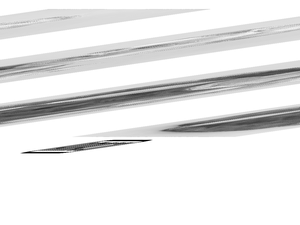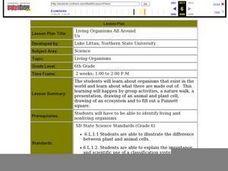Berkshire Museum
Meet a Naturalist: Researching, Writing, Interviewing
Young scholars reach out into the community and learn about different environmental science careers in this inquiry-based instructional activity. Beginning with a short research assignment, children gain background knowledge about...
American Psychological Association
Counting Fidgets: Teaching the Complexity of Naturalistic Observation
Why do psychologists conduct experiments in controlled laboratory settings? High schoolers gain an understanding of the importance of controls with an activity that involves naturalistic observations with no imposed controls.
Chicago Botanic Garden
Meet the Naturalists
Studying plants is a full-time job—for some. After learning the ins and outs of phenology in the first three lessons in the unit, pupils explore the history of the science. The instructional activity highlights five historical...
Curated OER
Discovering Art-Huntington Gallery Shape
Students study geometric, naturalistic, and abstract shapes. They discuss how various shapes are used in art. They study The Young Fortune Teller by Joshua Reynolds to find various shapes.
Curated OER
the Naturalist's Notebook
Third graders, after brainstorming what they already know about trees and what effect the seasons have on them, create a model of a hollow log. They participate in a young naturalist's notebook writing activity while walking outside...
Curated OER
Jane Goodall, Renowned Naturalist and Champion of Chimpanzees
Students study the life of Jane Goodall and how she made an impact studying chimpanzees. In this endangered species lesson students write in their journals.
Curated OER
Naturalist's Notebook
Students observe and record the behavior of a San Diego wetland animal and the characteristics of its environment. The amount of time that each animal spends resting, grooming, eating, flying, and social or individual play becomes the...
Curated OER
Bird Nests
Young scholars build bird nests. In this Science instructional activity, students consider climate, location, and structure when building their bird nest. Young scholars try to locate each other's nests within the activity site.
Curated OER
Discovering Art - Scott Gallery: Shape
Students study geometric, naturalistic, and abstract shapes in art. They review the names of shapes and name them in the portrait, Breakfast in Bed by Mary Cassatt. They simulate a baby as in the portrait and discuss the shapes. They...
Curated OER
Earth's Heavenly Treasures: Hummingbirds
Young ornithologists watch an informative video and use the Internet to gather data about the life, size, habitat, and migration of hummingbirds. The interdisciplinary lesson includes activities that target art, science, math, and...
Curated OER
Lesson #23: Ceramic Self-Portrait as a Famous Artist
Students sculpt a bust out of clay using naturalistic features. In this sculpture lesson, students use themselves or classmates as models to ensure correct form and proportion of a hollow bust. This lesson includes pictures for each...
Curated OER
Observation: It's A Natural!
Students play the role of naturalist in their own community just as Thoreau was in his. They observe their communities looking for positive and negative aspects on the environment. They work together in groups to complete a model for...
Curated OER
SOIL
Second graders name the various materials that comprise soil, including weathered rock and other organic matter; and explain that soils differ in their color, texture, capacity to retain water, and ability to support the growth of many...
Curated OER
Island Biogeography
Learners work in small groups to sort through photos of an ecosystem following a major disturbance. They place these photos in chronological order to show the process of succession. They then do an experiment with yeast to show the...
Curated OER
How Many Bears in the Forest?
Third graders model the tag and recapture of bears and use proportions to estimate the population of the bears in their forest. This is a statistical sampling method used by scientists and naturalists to determine population numbers.
Curated OER
Native American Ceremonies
Second graders explore cultural rituals by researching Native American people. For this Native American ceremony lesson, 2nd graders read the story Indian Festivals by Keith Brand and identify the naturalistic attitude of the Native...
Curated OER
Green Space in the City
Students examine city parks and their importance and affect they have on the health and well being of a community. An oral report with visual aids is prepared as a group to educate the class on the importance of green space in the city.
Curated OER
Julie of the Wolves
Have your class practice their comprehension skills using this resource. After reading Julie of the Wolves by Jean Craighead George, learners engage in cause and effect activities, identify story elements and figurative language, and...
Chicago Botanic Garden
Plant Phenology Data Analysis
Beginning in 1851, Thoreau recorded the dates of the first spring blooms in Concord, and this data is helping scientists analyze climate change! The culminating instructional activity in the series of four has pupils graph and analyze...
Curated OER
Crane, London, and Literary Naturalism
Learners analyze "To Build a Fire" by Jack London and "The Open boat" by Stephen Crane. They write an essay in which they compare and contrast the narrators and plots in each story.
Chicago Botanic Garden
Plant Phenology Data Analysis
Scientists monitor seasonal changes in plants to better understand their responses to climate change, in turn allowing them to make predictions regarding the future. The last activity in the series of six has scholars analyze BudBurst...
Curated OER
Living Organisms All Around Us
Sixth graders study organisms that exist in the world and what they are made up of. They participate in a nature walk, a presentation, a drawing of an animal and plant cell, draw a ecosystem, and fill out a Punnett square.
National Endowment for the Humanities
Tales of the Supernatural
Scary stuff! Whether approached as the first horror story or a "serious imaginative exploration of the human condition," Frankenstein continues to engage readers. Here's a packet of activities that uses Mary Shelley's gothic novel to...
Curated OER
History of Ponce de Leon in Florida
Based in sound Educational Theory, this lesson uses art to convey the story of Ponce de Leon. Mild to moderately disabled students hear the story of the Fountain of Youth, examine a paining of Ponce de Leon, and act out a scene as Ponce...
Other popular searches
- Naturalist Journal
- Naturalist Intelligence
- Naturalist Fiction
- Naturalist Learner
- What Is a Naturalist
- Naturalist Essay
- Immigrants and Naturalist
- Book the Super Naturalist
- Naturalist Coordinate Plane
- Nutrition, Naturalist
- Naturalistic Intelligence
- Immigration and Naturalist

























